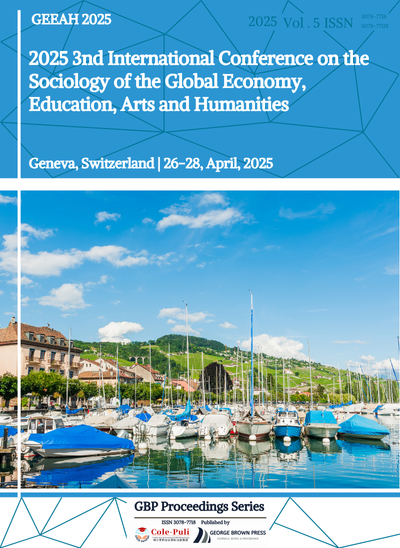A Review of Industrial Economic Structure and Efficiency from a Statistical Perspective
DOI:
https://doi.org/10.71222/xt068877Keywords:
industrial economic structure, economic efficiency, Data Envelopment Analysis, Stochastic Frontier Analysis, spatial statistics, machine learningAbstract
This paper provides a comprehensive review of industrial economic structure and efficiency through the lens of statistical methodologies. It systematically discusses key concepts such as technical, allocative, and scale efficiency, and critically evaluates widely used measurement techniques including Data Envelopment Analysis (DEA) and Stochastic Frontier Analysis (SFA). The paper further explores a broad spectrum of statistical tools — such as descriptive statistics, multivariate analysis, time series and panel data models, as well as spatial statistics and geographically weighted regression — and their applications in analyzing industrial dynamics. Empirical studies illustrating variations across different industries and regions are summarized, highlighting the importance of data quality and processing methods. The integration of traditional statistical approaches with emerging machine learning techniques is also examined, pointing toward future research directions. Finally, the study reflects on the practical implications for policy and industrial development, emphasizing both the strengths and limitations of statistical perspectives in industrial economics research.
References
1. M. Koengkan, J. A. Fuinhas, E. Kazemzadeh, F. Osmani, N. K. Alavijeh, A. Auza, and M. Teixeira, "Measuring the economic efficiency performance in Latin American and Caribbean countries: An empirical evidence from stochastic production frontier and data envelopment analysis," Int. Econ., vol. 169, pp. 43–54, 2022, doi: 10.1016/j.inteco.2021.11.004.
2. N. A. Bhat and S. Kaur, "Technical efficiency analysis of Indian IT industry: A panel data stochastic frontier approach," Millenn. Asia, vol. 15, no. 2, pp. 327–348, 2024, doi: 10.1177/09763996221082199.
3. L. T. Nguyen, S. Ratnasiri, and L. Wagner, "Industrial energy efficiency and determinants in Vietnam: A stochastic frontier analysis using firm-level data," Appl. Econ., vol. 56, no. 14, pp. 1636–1651, 2024, doi: 10.1080/00036846.2023.2177592.
4. C. Zhang and P. Chen, "Industrialization, urbanization, and carbon emission efficiency of Yangtze River Economic Belt—empirical analysis based on stochastic frontier model," Environ. Sci. Pollut. Res., vol. 28, no. 47, pp. 66914–66929, 2021, doi: 10.1007/s11356-021-15309-z.
5. M. C. D’Errico, "Sustainable economic growth and energy security nexus: A stochastic frontier analysis across OECD countries," Energy Econ., vol. 132, p. 107447, 2024, doi: 10.1016/j.eneco.2024.107447.
6. M. Wang, Y. Wu, X. Zhang, and L. Lei, "How does industrial agglomeration affect internal structures of green economy in China? An analysis based on a three-hierarchy meta-frontier DEA and systematic GMM approach," Technol. Forecast. Soc. Change, vol. 206, p. 123560, 2024, doi: 10.1016/j.techfore.2024.123560.
7. Z. Geng, G. Song, Y. Han, and C. Chu, "Static and dynamic energy structure analysis in the world for resource optimization using total factor productivity method based on slacks-based measure integrating data envelopment analysis," Energy Convers. Manage., vol. 228, p. 113713, 2021, doi: 10.1016/j.enconman.2020.113713.
8. T. Wang, K. Sun, and S. Kumbhakar, "A new semiparametric stochastic frontier model: addressing inefficiency and model flexibility using panel data," Empir. Econ., pp. 1–38, 2025, doi: 10.1007/s00181-024-02708-7.
9. J. Barrera-Santana, G. A. Marrero, and F. J. Ramos-Real, "Energy efficiency and energy governance: A stochastic frontier anal-ysis approach," Energy J., vol. 43, no. 6, pp. 243–284, 2022, doi: 10.5547/01956574.43.6.jbar.
10. A. E. Ripoll-Zarraga, J. L. F. Miguel, and C. F. Belda, "Visualisation of Data Envelopment Analysis in primary health services," Health Care Manag. Sci., pp. 1–27, 2025, doi: 10.1007/s10729-025-09702-0.
11. J. Zhou and M. Shao, "Evaluation of green innovation efficiency in Chinese provincial regions under high-quality development and its influencing factors: An empirical study based on hybrid data envelopment analysis and multilevel mixed-effects Tobit models," Sustainability, vol. 15, no. 14, p. 11079, 2023, doi: 10.3390/su151411079.
12. N. Arora, D. Sharma, and S. J. Talwar, "A sustainable measure of efficiency performance and validity of Environmental Kuznets Curve–an intercountry Data Envelopment Analysis approach," J. Econ. Adm. Sci., 2025, doi: 10.1108/JEAS-07-2024-0256.











